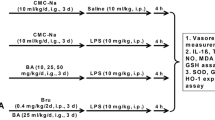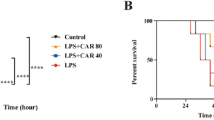Abstract
Lipopolysaccharide (LPS), a glycolipid component of the cell wall of gram-negative bacteria can elicit a systemic inflammatory process leading to septic shock and death. Acute phase response is characterized by fever, leucocytosis, thrombocytopenia, altered metabolic responses and redox balance by inducing excessive reactive oxygen species (ROS) generation. Resveratrol (trans-3,5,4′ trihydroxystilbene) is a natural polyphenol exhibiting antioxidant and anti-inflammatory properties. We investigated the protective effect of resveratrol on endotoxemia-induced acute phase response in rats. When acutely administered by i.p. route, resveratrol (40 mg/kg b.w.) counteracted the effect of a single injection of LPS (4 mg/kg b.w.) which induced fever, a decrease in white blood cells (WBC) and platelets (PLT) counts. When i.p. administered during 7 days at 20 mg/kg per day (subacute treatment), resveratrol abrogated LPS-induced erythrocytes lipoperoxidation and catalase (CAT) activity depression to control levels. In the plasma compartment, LPS increased malondialdehyde (MDA) via nitric monoxide (NO) elevation and decreased iron level. All these deleterious LPS effects were reversed by a subacute resveratrol pre-treatment via a NO independent way. Resveratrol exhibited potent protective effect on LPS-induced acute phase response in rats.




Similar content being viewed by others
Abbreviations
- CAT:
-
Catalase
- LPS:
-
Lipopolysaccharide
- MDA:
-
Malondialdehyde
- NO:
-
Nitric oxide
- NOS:
-
Nitric oxide synthase
- PLT:
-
Platelets
- ROS:
-
Reactive oxygen species
- RVT:
-
Resveratrol
- WBC:
-
White blood cells
References
Aebi H (1984) Catalase in vitro. Meth Enzymol 105:121–126
Aslam R, Speck ER, Kim M, Crow AR, Bang KW, Nestel FP, Ni H, Lazarus AH, Freedman J, Semple JW (2006) Platelet toll-like receptor expression modulates lipopolysaccharide-induced thrombocytopenia and tumor necrosis factor-alpha production in vivo. Blood 107:637–641
Bastianetto S, Zheng WH, Quirion R (2000) Neuroprotective abilities of resveratrol and other red wine constituents against nitric oxide-related toxicity in cultured hippocampal neurons. Br J Pharmacol 131:711–720
Baumann H, Gauldie J (1994) The acute phase response. Immunol Today 15:74–80
Bi XL, Yang JY, Dong YS, Wang JM, Cui YH, Ikeshima T, Zhao YQ, Wu CF (2005) Resveratrol inhibits nitric oxide and TNF-alpha production by lipopolysaccharide-activated microglia. Int Immunopharmacol 5:185–193
Cadenas S, Cadenas AM (2002) Fighting the stranger-antioxidant protection against endotoxin toxicity. Toxicology 180:45–63
Chander V, Tirkey N, Chopra K (2005) Resveratrol, a polyphenolic phytoalexin protects against cyclosporine-induced nephrotoxicity through nitric oxide dependent mechanism. Toxicology 210:55–64
Das DK, Sato M, Ray PS, Maulik G, Engelman RM, Bertelli AA, Bertelli A (1999) Cardioprotection of red wine: role of polyphenolic antioxidants. Drugs Exp Clin Res 25:115–120
Draper HH, Hadley M (1990) Malondialdehyde determination as index of lipid peroxidation. Meth Enzymol 186:421–431
Freudenberg MA, Galanos C (1990) Bacterial lipopolysaccharides: structure, metabolism and mechanisms of action. Int Rev Immunol 6:207–221
Ganz T (2005) Hepcidin—a regulator of intestinal iron absorption and iron recycling by macrophages. Best Pract Res Clin Haematol 18:171–182
Giovannini L, Migliori M, Longoni BM, Das DK, Bertelli AA, Panichi V, Filippi C, Bertelli A (2001) Resveratrol, a polyphenol found in wine, reduces ischemia reperfusion injury in rat kidneys. J Cardiovasc Pharmacol 37:262–270
Green LC, Wagner DA, Glogowski J, Shipper PL, Wishnok JS, Tannenbaum SR (1982) Analysis of nitrate, nitrite and [15N] nitrate in biological fluids. Anal Biochem 126:131–138
Halliwell B, Gutteridge JMC (1999) Free radicals in biology and medicine, 3rd edn. Oxford University Press, Oxford, 936 p
Hartree EF (1972) Determination of protein: a modification of the Lowry method that gives a linear photometric response. Anal Biochem 48:422–427
Hobbs AJ, Higgs A, Moncada S (1999) Inhibition of nitric oxide synthase as a potential therapeutic target. Annu Rev Pharmacol Toxicol 39:191–220
Hung LM, Chen JK, Lee RS, Liang HC, Su MJ (2001) Beneficial effects of astringinin, a resveratrol analogue, on the ischemia and reperfusion damage in rat heart. Free Radic Biol Med 30:877–883
Ikeda M, Nakabayashi K, Shinkai M, Hara Y, Kizaki T, Oh-ishi S, Ohno H (2004) Supplementation of antioxidants prevents oxidative stress during a deep saturation dive. Tohoku J Exp Med 203:353–357
Juan ME, Lamuela-Raventós RM, de la Torre-Boronat MC, Planas JM (1999) Determination of trans-resveratrol in plasma by HPLC. Anal Chem 71:747–750
Kanashiro A, Machado RR, Malvar Ddo C, Aguiar FA, Souza GE (2008) Quercetin does not alter lipopolysaccharide-induced fever in rats. J Pharm Pharmacol 60:357–362
Kanter M, Coskun O, Armutcu F, Uz YH, Kizilay G (2005) Protective effects of vitamin C, alone or in combination with vitamin A, on endotoxin-induced oxidative renal tissue damage in rats. Tohoku J Exp Med 206:155–162
Kitajima S, Tsuda M, Eshita N, Matsushima Y, Saitoh M, Momma J, Kurokawa Y (1995) Lipopolysaccharide-associated elevation of serum and urinary nitrite/nitrate levels and hematological changes in rats. Toxicol Lett 78:135–140
Kruzel ML, Harari Y, Mailman D, Actor JK, Zimecki M (2002) Differential effects of prophylactic, concurrent and therapeutic lactoferrin treatment on LPS-induced inflammatory responses in mice. Clin Exp Immunol 130:25–31
Leardi A, Caraglia M, Selleri C, Pepe S, Pizzi C, Notaro R, Fabbrocini A, De Lorenzo S, Musicò M, Abbruzzese A, Bianco AR, Tagliaferri P (1998) Desferioxamine increases iron depletion and apoptosis induced by ara-C of human myeloid leukaemic cells. Br J Haematol 102:746–752
Mokni M, Elkahoui S, Limam F, Amri M, Aouani E (2007a) Effect of resveratrol on antioxidant enzyme activities in the brain of healthy rat. Neurochem Res 32:981–987
Mokni M, Limam F, Elkahoui S, Amri M, Aouani E (2007b) Strong cardioprotective effect of resveratrol, a red wine polyphenol, on isolated rat hearts after ischemia/reperfusion injury. Arch Biochem Biophys 457:1–6
Olas B, Wachowicz B (2002) Resveratrol and vitamin C as antioxidants in blood platelets. Thromb Res 106:143–148
Soleas GJ, Diamandis EP, Goldberg DM (1997) Resveratrol: a molecule whose time has come? And gone? Clin Biochem 30:91–113
Sunil VR, Patel KJ, Nilsen-Hamilton M, Heck DE, Laskin JD, Laskin DL (2007) Acute endotoxemia is associated with upregulation of lipocalin 24p3/Lcn2 in lung and liver. Exp Mol Pathol 83:177–187
Theurl I, Theurl M, Seifert M, Mair S, Nairz M, Rumpold H, Zoller H, Bellmann-Weiler R, Niederegger H, Talasz H, Weiss G (2008) Autocrine formation of hepcidin induces iron retention in human monocytes. Blood 111:2392–2399
Thiemermann C, Ruetten H, Wu CC, Vane JR (1995) The multiple organ dysfunction syndrome caused by endotoxin in the rat: attenuation of liver dysfunction by inhibitors of nitric oxide synthase. Br J Pharmacol 116:2845–2851
Tunctan B, Uludag O, Altug S, Abacioglu N (1998) Effect of nitric oxide synthase inhibition in lipopolysaccharide-induced sepsis in mice. Pharmacol Res 38:405–411
Vallance P, Moncada S (1993) Role of endogenous nitric oxide in septic shock. New Horiz 1:77–86
Westphal M, Stubbe H, Sielenkämper AW, Borgulya R, Van Aken H, Ball C, Bone HG (2003) Terlipressin dose response in healthy and endotoxemic sheep: impact on cardiopulmonary performance and global oxygen transport. Intensive Care Med 29:154–155
Wilms LC, Kleinjans JC, Moonen EJ, Briedé JJ (2008) Discriminative protection against hydroxyl and superoxide anion radicals by quercetin in human leucocytes in vitro. Toxicol In Vitro 22:301–307
Zheng H, Fletcher D, Kozak W, Jiang M, Hofmann KJ, Corn CA, Soszynski D, Grabiec C, Trumbauer ME, Shaw A, Kostura MJ, Stevens K, Rosen H, North RJ, Chen HY, Tocci MJ, Kluger MJ, Van der Ploeg LHT (1995) Resistance to fever induction and impaired acute-phase response in interleukin-1β-deficient mice. Immunity 3:9–19
Acknowledgment
Financial support of the Tunisian Ministry of “Enseignement Supérieur, Recherche Scientifique et Technologie” is gratefully acknowledged.
Author information
Authors and Affiliations
Corresponding author
Rights and permissions
About this article
Cite this article
Sebai, H., Ben-Attia, M., Sani, M. et al. Protective effect of resveratrol in endotoxemia-induced acute phase response in rats. Arch Toxicol 83, 335–340 (2009). https://doi.org/10.1007/s00204-008-0348-0
Received:
Accepted:
Published:
Issue Date:
DOI: https://doi.org/10.1007/s00204-008-0348-0




